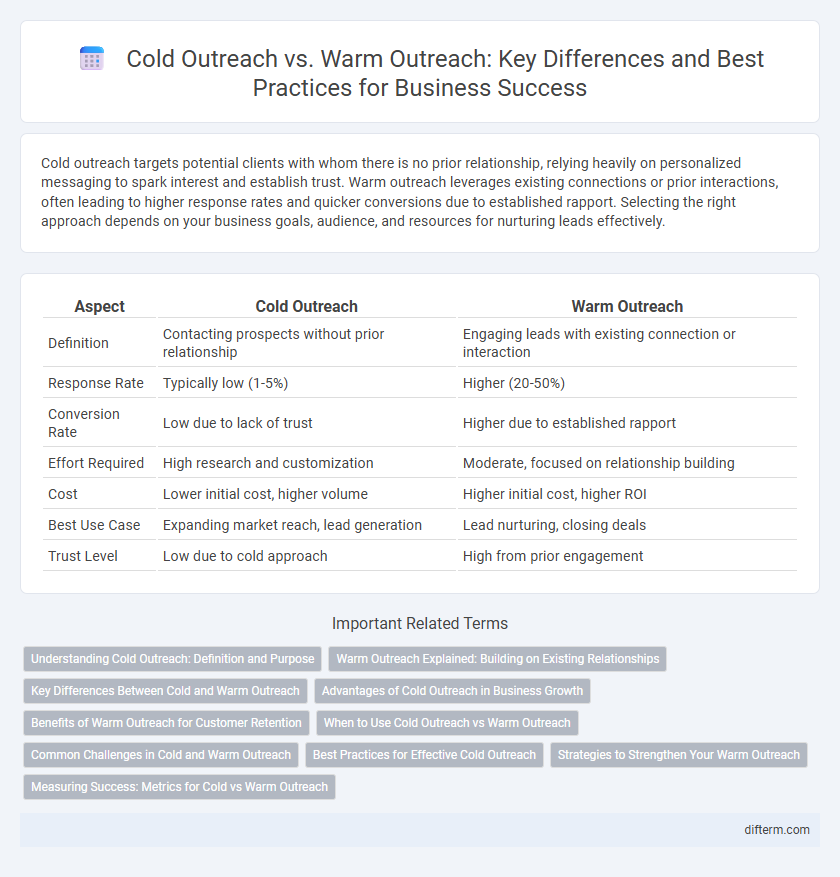Cold outreach targets potential clients with whom there is no prior relationship, relying heavily on personalized messaging to spark interest and establish trust. Warm outreach leverages existing connections or prior interactions, often leading to higher response rates and quicker conversions due to established rapport. Selecting the right approach depends on your business goals, audience, and resources for nurturing leads effectively.
Table of Comparison
| Aspect | Cold Outreach | Warm Outreach |
|---|---|---|
| Definition | Contacting prospects without prior relationship | Engaging leads with existing connection or interaction |
| Response Rate | Typically low (1-5%) | Higher (20-50%) |
| Conversion Rate | Low due to lack of trust | Higher due to established rapport |
| Effort Required | High research and customization | Moderate, focused on relationship building |
| Cost | Lower initial cost, higher volume | Higher initial cost, higher ROI |
| Best Use Case | Expanding market reach, lead generation | Lead nurturing, closing deals |
| Trust Level | Low due to cold approach | High from prior engagement |
Understanding Cold Outreach: Definition and Purpose
Cold outreach involves initiating contact with potential clients or leads without prior interaction, aiming to create new business opportunities from scratch. Its primary purpose is to expand a company's network by targeting individuals or businesses that have not yet expressed interest in its products or services. Effective cold outreach strategies leverage personalized messaging and market research to increase response rates and generate qualified leads.
Warm Outreach Explained: Building on Existing Relationships
Warm outreach leverages existing relationships and prior interactions to create personalized, trust-driven communication, significantly increasing response rates compared to cold outreach. It involves engaging prospects who have shown interest or have some familiarity with your brand, enabling tailored messaging that resonates on a deeper level. This approach accelerates the sales cycle by fostering rapport and demonstrating genuine understanding of the prospect's needs.
Key Differences Between Cold and Warm Outreach
Cold outreach targets prospects with no prior interaction, relying heavily on initial contact strategies like cold emails and calls to spark interest. Warm outreach engages leads who have shown previous interest or interaction, leveraging established relationships and personalized communication to increase conversion rates. The key difference lies in familiarity and trust level, with warm outreach typically resulting in higher engagement and response due to prior connection.
Advantages of Cold Outreach in Business Growth
Cold outreach enables businesses to access a broader audience beyond their immediate network, increasing market reach and potential client base. It drives lead generation by introducing products or services to prospects who may be unaware of the company, facilitating new business opportunities. Implementing scalable cold outreach strategies, such as targeted email campaigns, results in measurable growth metrics and enhances brand visibility in competitive markets.
Benefits of Warm Outreach for Customer Retention
Warm outreach fosters stronger customer retention by leveraging existing relationships and trust, leading to higher engagement rates and increased loyalty. Personalized communication tailored to previous interactions enhances customer satisfaction and reduces churn. Businesses employing warm outreach experience better conversion rates and long-term revenue growth through sustained client connections.
When to Use Cold Outreach vs Warm Outreach
Cold outreach is ideal for expanding your network or entering new markets where no prior relationship exists, targeting prospects with tailored, research-backed messages to capture attention. Warm outreach works best when you have existing connections or prior interactions, allowing you to leverage familiarity and trust to drive engagement and conversions. Selecting the right approach depends on your campaign goals, lead qualification, and the stage of the buyer's journey.
Common Challenges in Cold and Warm Outreach
Cold outreach often struggles with low response rates due to lack of prior relationship and trust, making it difficult to capture attention in saturated markets. Warm outreach faces challenges in maintaining engagement and nurturing leads without appearing intrusive, as recipients may have varying levels of interest and readiness to convert. Both approaches require tailored messaging and precise targeting to overcome obstacles in building meaningful business connections.
Best Practices for Effective Cold Outreach
Effective cold outreach requires personalized messaging that addresses the prospect's specific pain points and demonstrates clear value. Utilizing data-driven targeting and multi-channel approaches such as email, phone calls, and social media interactions increases engagement rates. Consistent follow-ups combined with concise, compelling communication foster trust and improve response rates in cold outreach campaigns.
Strategies to Strengthen Your Warm Outreach
Leveraging personalized messaging and detailed customer insights significantly boosts the effectiveness of warm outreach campaigns. Incorporating data-driven segmentation allows businesses to tailor offers and communication precisely to prospect needs, enhancing engagement rates. Building rapport through consistent follow-ups and value-driven touchpoints transforms warm leads into loyal customers.
Measuring Success: Metrics for Cold vs Warm Outreach
Measuring success in cold outreach primarily relies on metrics such as response rates, cold email open rates, and conversion rates from initial contact to qualified leads. Warm outreach typically shows higher engagement rates, with a focus on deeper metrics like meeting scheduled rates, pipeline progression, and customer lifetime value attributed to these touchpoints. Comparing these metrics helps businesses optimize resource allocation and tailor strategies for cold versus warm outreach campaigns.
Cold Outreach vs Warm Outreach Infographic

 difterm.com
difterm.com